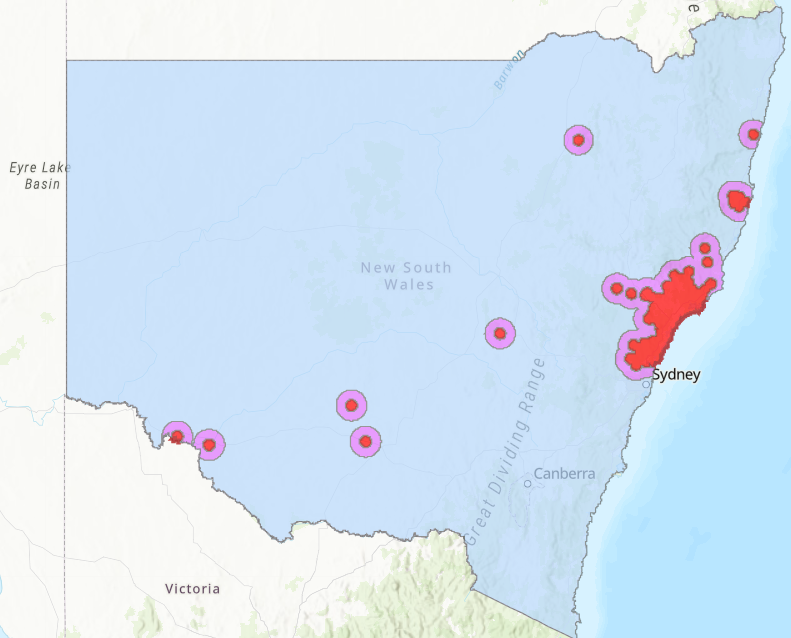Bee alert: new Varroa mite outbreaks threaten industry
Kristin Murdock
31 August 2023, 3:40 AM
 The Western Plain is part of the state emergency zone where vigilance around Varroa mite infestations is vital.
The Western Plain is part of the state emergency zone where vigilance around Varroa mite infestations is vital.In the last week, the deadly Varroa mite has been detected in beehives recently moved from Kempsey to four locations in almond pollination areas in the Riverina region. With the latest in Balranald.
The new detections bring the total number of infested premises to 222.
A Biosecurity (Varroa mite) emergency order was issued by the NSW Department of Primary Industries (DPI) and new emergency zones for eradication (red) and surveillance (purple) were created.
On Tuesday 29 August the DPI announced that beekeepers would be permitted to move beehives out of the purple zones in those almond areas to manage biosecurity risks and allow the bees to be properly fed.
Beekeepers in areas like the Western Plains are urged to remain vigilant.
“We know the infested hives we have identified by tracing movements from the Kempsey region have only been in these almond orchards for a short time and with plenty of floral resources the bees would not have travelled far,” said NSW DPI Chief Plant Protection Officer Shane Hetherington.
“That means the risk of them transferring mites to hives outside the red zone to hives in the purple zone is negligible.
“However, the floral resources are rapidly running out as the almond orchards finish the flowering period and bees will begin to rob neighboring hives which creates a significant biosecurity risk.
The Emergency Order would normally prevent the movement of all surrounding hives out of eradication and surveillance zones as a precaution, however, Dr Hetherington says the Emergency Order has been amended "to reduce the chances of bees from those few infested hives mixing with bees from other hives and spreading the mite.”
Beekeepers will need to adhere to strict rules around Movement of bees (nsw.gov.au) out of the surveillance zones at Euston, Euroley, Nericon and Balranald.
Eradication remains the aim
Varroa mites are tiny red-brown external parasites of honey bees that mainly feed and reproduce on larvae and pupae of bees, causing malformation and weakening of honey bees as well as transmitting numerous viruses.
Varroa mite was first detected in Australia during routine surveillance by NSW Bee Biosecurity Officers at Newcastle on June 2022. The centre of the outbreak was traced further away from the port, but still within the Newcastle area.
In 2022, further infected premises were found in the greater Newcastle area, the Hunter Valley Central Coast, and on the mid-north coast at Kramback and Wherrol Flat. There were also single properties infected near Narrabri, on the north coast near Coffs Harbour, and one near Gumble, near Orange.
Professor Sasha Mikheyev from The Australian National University (ANU) said that while the NSW government is working hard to contain and eliminate the infestation, no other country has succeeded, and the risk of an Australian spread remains high.
"What makes eradication so difficult is that we have a very large population of feral western honey bees that live in the bush and are very hard to locate, so even if mite infected hives can be detected and destroyed, it is much harder to do the same with feral colonies," he said.
According to industry body, BeeAware, the effect of Varroa mite in other countries has seen wild honey bee colonies and managed colonies drastically decline.
In the USA and Europe, Varroa mite killed 95-100 per cent of unmanaged or wild honey bees within three to four years of infestation.

The emergency zones as at 29 August 2023. SOURCE: NSW DPI
A 10km eradication zone and a 25km surveillance zone is now in place around infected areas, meaning hives cannot be moved into, within or out of these zones.
While not in an eradication or surveillance zone, the Western Plains is part of a general emergency zone, as is all of NSW. No other states are affected at this stage.
When contacted by Western Plains App, a spokesperson from DPI said while the Western Plains region is not affected by Varroa mite, residents need to be vigilant.
"Everyone needs to be informed and any new outbreak is recorded and detailed on the DPI for public knowledge."
DPI provides emergency response maps with reports on the situation which are constantly updated, the DPI spokesperson told Western Plains App.
"Everyone needs to be aware of the situation and this is the best way we can keep people informed."
WHAT'S ON




